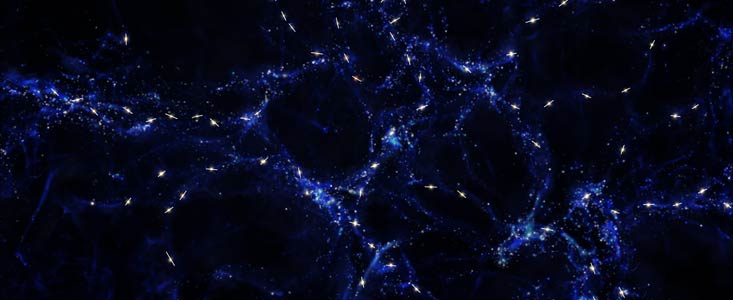Press Release
Spooky Alignment of Quasars Across Billions of Light-years
VLT reveals alignments between supermassive black hole axes and large-scale structure
19 November 2014
New observations with ESO’s Very Large Telescope (VLT) in Chile have revealed alignments over the largest structures ever discovered in the Universe. A European research team has found that the rotation axes of the central supermassive black holes in a sample of quasars are parallel to each other over distances of billions of light-years. The team has also found that the rotation axes of these quasars tend to be aligned with the vast structures in the cosmic web in which they reside.
Quasars are galaxies with very active supermassive black holes at their centres. These black holes are surrounded by spinning discs of extremely hot material that is often spewed out in long jets along their axes of rotation. Quasars can shine more brightly than all the stars in the rest of their host galaxies put together.
A team led by Damien Hutsemékers from the University of Liège in Belgium used the FORS instrument on the VLT to study 93 quasars that were known to form huge groupings spread over billions of light-years, seen at a time when the Universe was about one third of its current age.
“The first odd thing we noticed was that some of the quasars’ rotation axes were aligned with each other — despite the fact that these quasars are separated by billions of light-years,” said Hutsemékers.
The team then went further and looked to see if the rotation axes were linked, not just to each other, but also to the structure of the Universe on large scales at that time.
When astronomers look at the distribution of galaxies on scales of billions of light-years they find that they are not evenly distributed. They form a cosmic web of filaments and clumps around huge voids where galaxies are scarce. This intriguing and beautiful arrangement of material is known as large-scale structure.
The new VLT results indicate that the rotation axes of the quasars tend to be parallel to the large-scale structures in which they find themselves. So, if the quasars are in a long filament then the spins of the central black holes will point along the filament. The researchers estimate that the probability that these alignments are simply the result of chance is less than 1%.
“A correlation between the orientation of quasars and the structure they belong to is an important prediction of numerical models of evolution of our Universe. Our data provide the first observational confirmation of this effect, on scales much larger that what had been observed to date for normal galaxies,” adds Dominique Sluse of the Argelander-Institut für Astronomie in Bonn, Germany and University of Liège.
The team could not see the rotation axes or the jets of the quasars directly. Instead they measured the polarisation of the light from each quasar and, for 19 of them, found a significantly polarised signal. The direction of this polarisation, combined with other information, could be used to deduce the angle of the accretion disc and hence the direction of the spin axis of the quasar.
“The alignments in the new data, on scales even bigger than current predictions from simulations, may be a hint that there is a missing ingredient in our current models of the cosmos,” concludes Dominique Sluse.
More information
This research was presented in a paper entitled “Alignment of quasar polarizations with large-scale structures“, by D. Hutsemékers et al., to appear in the journal Astronomy & Astrophysics on 19 November 2014.
The team is composed of D. Hutsemékers (Institut d’Astrophysique et de Géophysique, Université de Liège, Liège, Belgium), L. Braibant (Liège), V. Pelgrims (Liège) and D. Sluse (Argelander-Institut für Astronomie, Bonn, Germany; Liège).
ESO is the foremost intergovernmental astronomy organisation in Europe and the world’s most productive ground-based astronomical observatory by far. It is supported by 15 countries: Austria, Belgium, Brazil, Czechia, Denmark, France, Finland, Germany, Italy, the Netherlands, Portugal, Spain, Sweden, Switzerland and the United Kingdom. ESO carries out an ambitious programme focused on the design, construction and operation of powerful ground-based observing facilities enabling astronomers to make important scientific discoveries. ESO also plays a leading role in promoting and organising cooperation in astronomical research. ESO operates three unique world-class observing sites in Chile: La Silla, Paranal and Chajnantor. At Paranal, ESO operates the Very Large Telescope, the world’s most advanced visible-light astronomical observatory and two survey telescopes. VISTA works in the infrared and is the world’s largest survey telescope and the VLT Survey Telescope is the largest telescope designed to exclusively survey the skies in visible light. ESO is the European partner of a revolutionary astronomical telescope ALMA, the largest astronomical project in existence. ESO is currently planning the 39-metre European Extremely Large optical/near-infrared Telescope, the E-ELT, which will become “the world’s biggest eye on the sky”.
Links
Contacts
Damien Hutsemékers
Institut d’Astrophysique et de Géophysique — Université de Liège
Liège, Belgium
Tel: +32 4 366 9760
Email: hutsemekers@astro.ulg.ac.be
Dominique Sluse
Institut d'Astrophysique et de Géophysique — Université de Liège
Liège, Belgium
Tel: +32 4 366 9797
Email: dsluse@ulg.ac.be
Richard Hook
ESO education and Public Outreach Department
Garching bei München, Germany
Tel: +49 89 3200 6655
Cell: +49 151 1537 3591
Email: rhook@eso.org
About the Release
| Release No.: | eso1438 |
| Name: | Quasar |
| Type: | Early Universe : Galaxy : Activity : AGN : Quasar |
| Facility: | Very Large Telescope |
| Instruments: | FORS2 |
| Science data: | 2014A&A...572A..18H |



